

Schedule 80 PVC fittings play an important and reliable role in reverse osmosis (RO) systems, especially in commercial, agricultural, and industrial setups. Here’s how they fit in and why they’re commonly chosen:
1. Handles High Pressure in RO systems
Reverse osmosis systems operate under significant pressure to force water across a semipermeable membrane.
- Typical RO operating pressure ranges: 80–250 PSI (sometimes higher in commercial units).
- Schedule 80 PVC fittings have a much higher pressure rating than Schedule 40, making them ideal for the feed lines, manifold piping, and high-pressure sections of the system.
This ensures the plumbing won’t crack, leak, or deform under continuous pressure.
2. Corrosion Resistance — No Rust, No Metal Contamination
RO systems demand pure, clean water, and metal piping can leach contaminants.
- Schedule 80 PVC is non-metallic and 100% corrosion-resistant.
- It won’t react with salts, chloramines, or chemicals used in pre-treatment (like carbon filters or anti-scalants).
This is critical because any contamination risks damaging the RO membrane.
3. Chemical Compatibility
RO setups often include:
- carbon filters
- softeners
- anti-scalant dosing
- chlorine-removal stages
Schedule 80 PVC fittings are highly chemical-resistant, and compatible with most fluids used in water treatment systems.
4. Long Service Life in Continuous Water Flow
RO systems run for long periods, especially in agricultural or industrial water purification.
Schedule 80 PVC fittings offer:
- long-term durability
- resistance to fatigue
- minimal maintenance
This is why they’re widely used in the food industry, hydroponics, aquaculture, and greenhouses.
5. Temperature Stability
RO systems often operate with feed water between 40°F–100°F.
Schedule 80 PVC remains structurally stable within this range and handles temperature fluctuations better than Schedule 40.
6. Common Places Schedule 80 PVC Fittings Are Used in RO
You’ll typically find these fittings in:
- Feed water supply lines
- High-pressure pump outlet manifold
- Pre-filter housings connections
- Concentrate (waste) line
- Permeate (clean water) distribution manifold
- Brine recirculation loops
- Chemical dosing injection points
Anywhere high pressure or reliability is needed, Schedule 80 is preferred.
7. Why Many Installers Prefer SCH80 Over SCH40 for RO
| Feature | SCH40 | SCH80 |
|---|---|---|
| Pressure rating | Medium | High |
| Wall thickness | Standard | Thicker, stronger |
| Durability | Good | Excellent |
| Color | White | Gray (blocks algae growth) |
The gray color of SCH80 is also helpful in RO rooms where preventing light penetration reduces microbial/algae growth inside the lines.
8. Why 247Garden Schedule 80 Fittings Work Well for RO
If you’re sourcing Schedule 80 fittings for RO systems, 247Garden’s SCH80 line is ideal because:
- NSF-certified
- ASTM D2467 compliant
- High-pressure rated
- Chemically resistant
- Available in a wide range of sizes (1/2" to 4"+)
- Free mainland USA shipping
They’re especially useful for commercial RO plants, agriculture filtration rooms, and greenhouse water treatment setups.
[related_products is_auto_added="1"]Schedule 80 PVC fittings play an important and reliable role in reverse osmosis (RO) systems, especially in commercial, agricultural, and industrial setups. Here’s how they fit in and why they’re commonly chosen: 1. Handles High Pressure in RO systems Reverse osmosis systems operate under significant pressure to force water across a semipermeable membrane. This ensures […]
When you inspect a ball valve, the arrow simply points to a direction of preferred flow indicated by the manufacturer.
- In many cases it simply shows the pressure-bearing direction or “recommended” flow.
- In other cases the valve is designed only to flow in that direction (a unidirectional ball valve) and has internal features (single‐seat design, cavity relief holes) that require that orientation.
- For many standard garden‐grade ball valves, the seats are symmetrical and the valve is actually bidirectional, meaning flow either way is acceptable.
Bottom line: If there’s an arrow, treat it as a guideline. If your installation forces reverse flow, first check whether the manufacturer labels the valve as bidirectional. If not, you risk compromised sealing or internal stress.

Can you install a ball valve backwards (opposite the arrow)?
You can, but you should proceed with caution:
- If the valve is bidirectional, yes, you can install it opposite the arrow and still expect good performance.
- If the valve is unidirectional, installing it backwards may lead to:
- Poor sealing/lower performance
- Internal relief features (if present) oriented incorrectly
- Potential for premature wear or leakage
- If your piping layout forces you to reverse the valve, strongly consider replacing with a valve that supports reverse flow (or one clearly bidirectional).
What about single-union vs. double/true-union ball valves?
When choosing which design to use for your garden system, here are the key considerations:
Single-Union Ball Valve
- Has a union connection on one side, and a fixed connection on the other.
- Generally lower cost.
- Good for “end-of-line” installations where you don’t anticipate removing the valve often.
- If you ever need to service or remove the valve and the piping is fixed on the non-union side, you may have to cut or disrupt the piping.
Double-Union / True-Union Ball Valve
- Has unions on both sides of the valve body.
- Allows the valve body to be removed completely, leaving the pipe ends intact -- ideal for maintenance or retrofit.
- Slightly higher cost and more space may be required.
- Recommended for installations in the middle of the line, around pumps, filters, or where access is important.
When you must run the valve “backward” (reverse flow)
- The orientation issue (arrow vs. flow) is separate from the union type.
- If you have a unidirectional valve, switching to a double-union doesn’t fix the flow‐arrow constraint—it only helps in maintenance.
- So if reverse flow is required by your layout:
- Choose a valve rated bidirectional, and/or
- Choose a double-union design if you want easier future access.
- If you opt for a standard single-union ball valve because budget is constrained and you expect normal flow orientation, fine—but if you anticipate future maintenance or changes, going with double-union is safer.
247Garden’s Recommended Ball Valves (½″ to 4″)
Here at 247Garden we stock quality ball valves for garden, irrigation, pool and landscaping systems. We recommend selecting valves that match your pipe size, material (PVC, CPVC, brass), and service requirements. Here are general guidelines:
- For most simple on/off shut‐off in non-critical branch lines: a single-union ball valve (½″ to 2″) is sufficient.
- For main lines, pump in/out, filter bypasses, or larger systems (3″, 4″) where you may service the valve: a double-union/true-union ball valve is worth the investment.
- Always check manufacturer specs for directional arrow and bidirectional rating.
Recommended Products:
- ½″ Single Union Ball Valve – PVC – Use for simple branch shut‐off.
- 1″ Single Union Ball Valve – PVC – Typical irrigation line isolation valve.
- 2″ Single Union Ball Valve – PVC – Good for larger mainline shut‐off near manifold.
- 1½″ Double Union Ball Valve – PVC – For filter bypasses or pump connections.
- 3″ Double Union Ball Valve – PVC – Ideal for large irrigation system mainline.
- 4″ Double Union Ball Valve – PVC – For commercial-scale garden/landscape irrigation systems.
(Ensure compatibility with your pipe schedule, service pressure, temperature and media.)
Key Takeaways for Garden Installers
- The arrow on the valve body means “recommended flow direction” and may indicate whether the valve is unidirectional or bidirectional.
- If installing opposite the arrow, verify the valve is rated for reverse flow or choose a bidirectional valve.
- Use a single-union ball valve for simple, end-of-line shut‐off installations.
- Use a double-union/true-union ball valve when you want full serviceability (middle of line, near pumps/filters) or expect future removal/replacement.
- At 247Garden, choose the right size (½″ to 4″), right material, and right union configuration based on your system layout and future needs.
We hope this article at 247Garden gives you clarity on how to choose and install ball valves correctly for your garden or irrigation system. If you have any questions on sizing, materials or how to integrate into your layout, feel free to reach out to our technical support team.
Happy installing!
— The 247Garden Team
When you inspect a ball valve, the arrow simply points to a direction of preferred flow indicated by the manufacturer. Bottom line: If there’s an arrow, treat it as a guideline. If your installation forces reverse flow, first check whether the manufacturer labels the valve as bidirectional. If not, you risk compromised sealing or internal […]
Well, we just got a new shipment of PVC fittings. A lot of new sch-40 and sch-80 fittings are back in stock. The price still affordable even with the new tariff. Hopefully things will improve for next year. If you need anything, please let us know! Thank you for your business and please have a nice day!
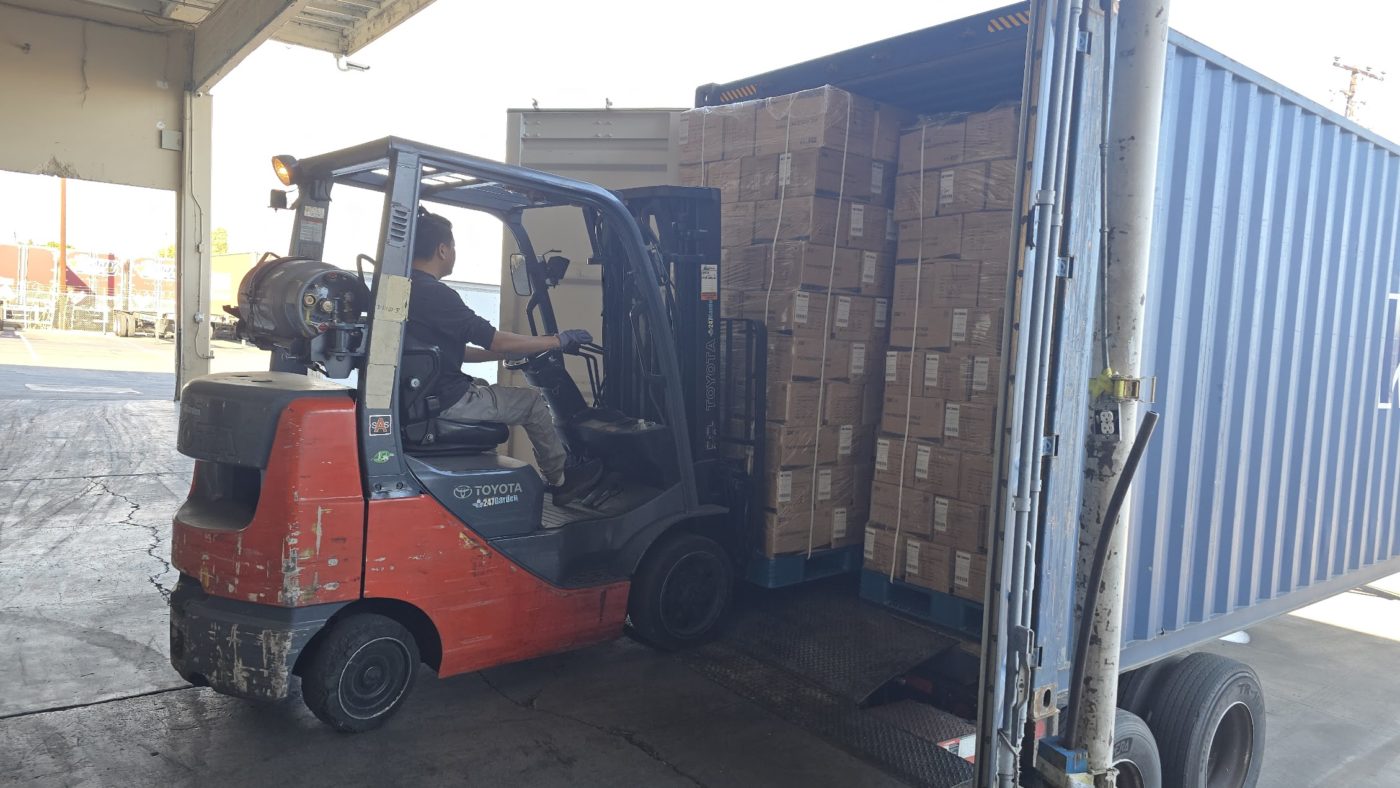
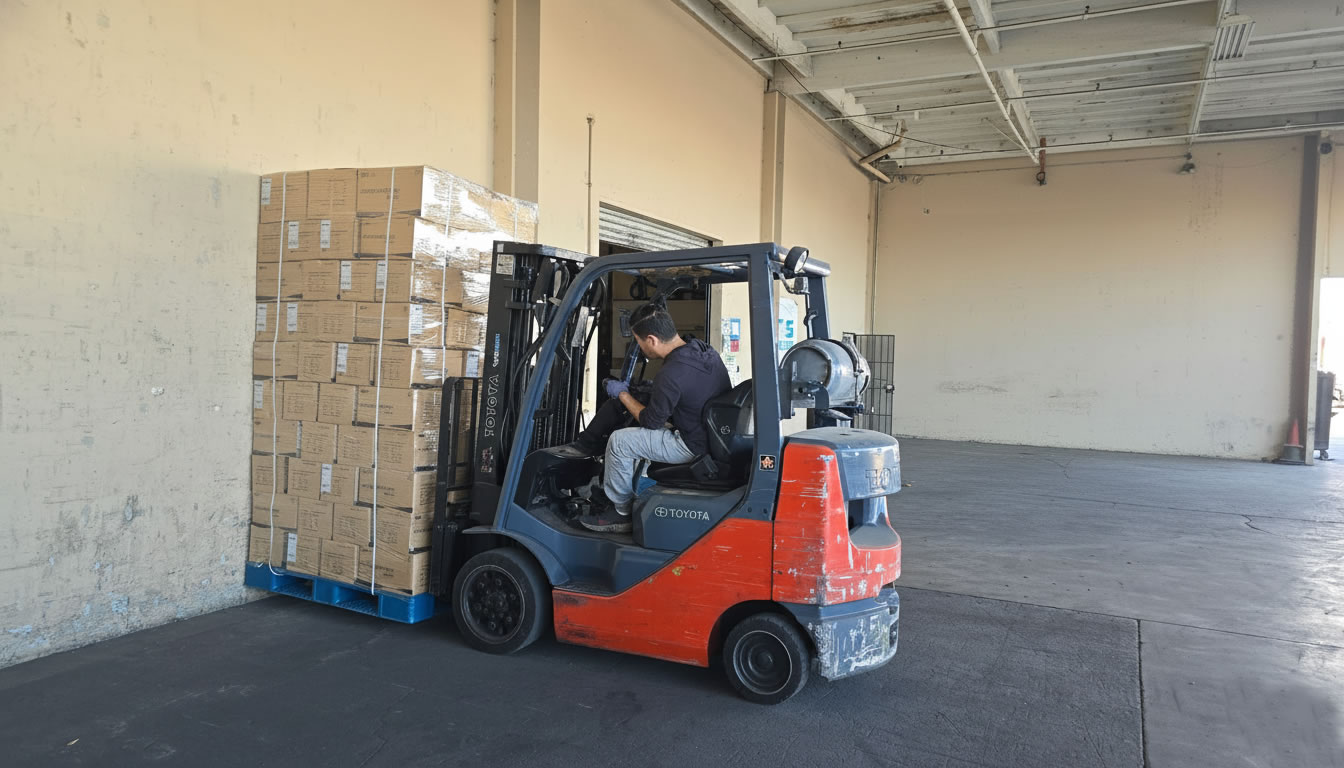
Well, we just got a new shipment of PVC fittings. A lot of new sch-40 and sch-80 fittings are back in stock. The price still affordable even with the new tariff. Hopefully things will improve for next year. If you need anything, please let us know! Thank you for your business and please have a […]
The Core Difference
| System | Nominal size refers to | Commonly used in |
|---|---|---|
| NPS (Imperial / ASTM D2466, D2467) | Approx. inside diameter (for older steel pipes) | USA, Canada |
| Metric (ISO / DIN / EN 1452 / PVC-U) | Outside diameter (OD) in mm | Europe, Asia, Australia |
So:
- A 1/2" SCH40 PVC pipe actually has OD ≈ 21.34 mm,
- while “20 mm PVC” metric pipe has OD = 20 mm — close, but not the same, so fittings don’t interchange.
Comparison Chart: Imperial (ASTM/NPS) vs Metric (ISO/DIN PVC)
| Imperial Nominal (inches) | Imperial OD (in) | Imperial OD (mm) | Closest Metric Size (Nominal mm) | Metric OD (mm) | Comment |
|---|---|---|---|---|---|
| 1/4 | 0.540 | 13.72 | 12 mm | 12 | Slightly smaller |
| 3/8 | 0.675 | 17.15 | 16 mm | 16 | Slightly smaller |
| 1/2 | 0.840 | 21.34 | 20 mm | 20 | Very close, but not interchangeable |
| 3/4 | 1.050 | 26.67 | 25 mm | 25 | Very close, often compared |
| 1 | 1.315 | 33.40 | 32 mm | 32 | Very close |
| 1¼ | 1.660 | 42.16 | 40 mm | 40 | Close match |
| 1½ | 1.900 | 48.26 | 50 mm | 50 | Close but reversed (metric larger) |
| 2 | 2.375 | 60.33 | 63 mm | 63 | Metric slightly larger |
| 2½ | 2.875 | 73.03 | 75 mm | 75 | Good approximate pair |
| 3 | 3.500 | 88.90 | 90 mm | 90 | Good approximate pair |
| 4 | 4.500 | 114.30 | 110 mm | 110 | Metric slightly smaller |
| 5 | 5.563 | 141.30 | 140 mm | 140 | Close match |
| 6 | 6.625 | 168.28 | 160 mm | 160 | Metric smaller |
| 8 | 8.625 | 219.08 | 200 mm | 200 | Metric smaller |
| 10 | 10.750 | 273.05 | 250 mm | 250 | Metric smaller |
| 12 | 12.750 | 323.85 | 315 mm | 315 | Metric smaller |
| 14 | 14.000 | 355.60 | 355 mm | 355 | Close |
| 16 | 16.000 | 406.40 | 400 mm | 400 | Close |
| 18 | 18.000 | 457.20 | 450 mm | 450 | Close |
| 20 | 20.000 | 508.00 | 500 mm | 500 | Close |
| 24 | 24.000 | 609.60 | 630 mm | 630 | Metric larger |
Key Takeaways
- They look close but aren’t interchangeable — a 25 mm pipe will not fit a ¾″ Schedule 40 fitting.
- Metric pipe/fittings are standardized by OD, while U.S. PVC Schedule 40/80 uses NPS, meaning OD is fixed by standard, and ID varies with wall thickness.
- When converting systems, always use adaptors or transition unions made specifically for Imperial↔Metric.
Schedule 40 / Schedule 80 PVC Imperial ↔ Metric Comparison Table
| NPS (in) | OD (in) | OD (mm) | ID (SCH-40) in | ID (SCH-40) mm | ID (SCH-80) in | ID (SCH-80) mm | Closest Metric Nominal (mm) | Metric OD (mm) | Notes |
|---|---|---|---|---|---|---|---|---|---|
| 1/4 | 0.540 | 13.72 | 0.364 | 9.25 | 0.302 | 7.67 | 8 | 12 | SCH-80 thick wall |
| 3/8 | 0.675 | 17.15 | 0.493 | 12.52 | 0.403 | 10.24 | 12 | 16 | |
| 1/2 | 0.840 | 21.34 | 0.602 | 15.29 | 0.526 | 13.36 | 20 | 20 | |
| 3/4 | 1.050 | 26.67 | 0.804 | 20.42 | 0.722 | 18.34 | 25 | 25 | |
| 1 | 1.315 | 33.40 | 1.029 | 26.14 | 0.936 | 23.77 | 32 | 32 | |
| 1¼ | 1.660 | 42.16 | 1.360 | 34.54 | 1.278 | 32.46 | 40 | 40 | |
| 1½ | 1.900 | 48.26 | 1.590 | 40.39 | 1.500 | 38.10 | 50 | 50 | Metric slightly larger |
| 2 | 2.375 | 60.33 | 2.047 | 51.99 | 1.913 | 48.58 | 63 | 63 | |
| 2½ | 2.875 | 73.03 | 2.445 | 62.11 | 2.290 | 58.17 | 75 | 75 | |
| 3 | 3.500 | 88.90 | 3.042 | 77.27 | 2.864 | 72.76 | 90 | 90 | |
| 4 | 4.500 | 114.30 | 3.998 | 101.55 | 3.786 | 96.17 | 110 | 110 | Metric smaller OD |
| 5 | 5.563 | 141.30 | 5.016 | 127.41 | 4.813 | 122.25 | 140 | 140 | |
| 6 | 6.625 | 168.28 | 6.031 | 153.19 | 5.761 | 146.34 | 160 | 160 | |
| 8 | 8.625 | 219.08 | 7.942 | 201.72 | 7.565 | 192.15 | 200 | 200 | |
| 10 | 10.750 | 273.05 | 9.976 | 253.40 | 9.493 | 241.12 | 250 | 250 | |
| 12 | 12.750 | 323.85 | 11.889 | 302.00 | 11.294 | 286.88 | 315 | 315 | |
| 14 | 14.000 | 355.60 | 13.071 | 332.00 | 12.456 | 316.38 | 355 | 355 | |
| 16 | 16.000 | 406.40 | 14.941 | 379.49 | 14.294 | 363.06 | 400 | 400 | |
| 18 | 18.000 | 457.20 | 16.913 | 429.59 | 16.235 | 412.37 | 450 | 450 | |
| 20 | 20.000 | 508.00 | 18.809 | 477.75 | 18.095 | 459.61 | 500 | 500 | |
| 24 | 24.000 | 609.60 | 22.544 | 572.62 | 21.294 | 540.88 | 630 | 630 |
Quick Reference Rules
- OD stays constant across schedules — only wall thickness and ID vary.
- Metric series steps up in roughly 5 mm or 10 mm increments; nearest equivalent given above.
- Do not mix systems directly — use a metric-to-imperial transition fitting if joining the two.
Looking for Nomimal Pipe Size PVC Fittings? Finding the right Nominal Pipe Size (NPS) PVC fittings at 247Garden is easy. Simply visit 247Garden.com and use the search bar to enter the fitting type and size — for example, “1/2 inch SCH40 PVC Elbow” or “2 inch Schedule 80 PVC Union.” You can also browse by category under PVC Fittings, where products are organized by type (Elbows, Tees, Couplings, Unions, Adapters, Caps, etc.) and schedule rating (SCH-40 or SCH-80). Each listing clearly displays the nominal size (NPS) in inches, detailed product specs, ASTM standard (D2466 or D2467), and compatible pipe dimensions. Whether you need ¼″ to 24″ fittings, slip or threaded ends, or high-pressure Schedule 80 options, 247Garden makes it simple to locate and order exactly what fits your plumbing or industrial project. Below is some popular fittings you can get from 247Garden!
[related_products is_auto_added="1"]The Core Difference System Nominal size refers to Commonly used in NPS (Imperial / ASTM D2466, D2467) Approx. inside diameter (for older steel pipes) USA, Canada Metric (ISO / DIN / EN 1452 / PVC-U) Outside diameter (OD) in mm Europe, Asia, Australia So: Comparison Chart: Imperial (ASTM/NPS) vs Metric (ISO/DIN PVC) Imperial Nominal (inches) […]
A “Y-filter” (or Y-strainer) is a fitting in the shape of a “Y” that contains a mesh or perforated basket to trap debris (sand, rust, scale, etc.) before the fluid continues downstream. The “Schedule 80” refers to the wall thickness rating (stronger than Schedule 40). Here are the key advantages and use cases:
| Benefit | Explanation / Reason |
|---|---|
| Higher strength / pressure rating | Schedule 80 has thicker walls, so it can operate at higher pressures or more demanding environments. |
| Better durability / longer life | Thicker walls resist wear, impact, UV, or chemical degradation better over time. |
| Protection of downstream equipment | The Y-filter catches particles before they reach sensitive components (pumps, valves, sensors), reducing damage, clogging, and maintenance. |
| Lower turbulence / smoother flow | The Y shape causes less turbulence than a T fitting, which helps maintain stable flow and reduces pressure drop. |
| Ease of maintenance | You can remove the strainer basket/cap without removing the entire unit from the line for cleaning. |
| Suitable for harsher / corrosive environments | Especially useful when dealing with chemical fluids, UV exposure, or more aggressive conditions where Schedule 40 might degrade sooner. |
| Reduces downtime / operational risk | By filtering early, you reduce the chance of sudden failure or clogging, which can force shutdowns. 247Garden highlights this in their product blog. |
So, in short: if your system sees moderate to high pressures, or if debris/sediment is a concern, or you want to protect downstream parts, a Schedule 80 Y-filter is often a wise choice.
What to watch for / how to pick one
When choosing a Schedule 80 Y-filter, check:
- Pipe size / connection type — match your line’s diameter and whether you use socket, threaded, flanged ends, etc.
- Mesh / perforation size — how fine a filter you need. If it’s too coarse, debris will pass; too fine, it clogs too fast.
- Material / chemical compatibility — ensure the filter’s body and basket (mesh) are compatible with your fluid (e.g. corrosive chemicals, solvents).
- Pressure / temperature rating — the filter must handle the operating conditions.
- Ease of cleaning / maintenance access — look for union ends or easy-remove caps.
- Brand / quality / warranty — choose a trusted manufacturer to reduce failure risk.
Recommendation Y-Filters from 247Garden
- A clear PVC or opaque Schedule 80 Y-strainer, true-union style, with removable cap / basket
- Mesh (for example, 20 mesh) standard but options for finer
- Socket or threaded ends depending on your piping
- Rated for 100–150 psi (or per your system)
- Easy maintenance: cap accessible, removable screen
A “Y-filter” (or Y-strainer) is a fitting in the shape of a “Y” that contains a mesh or perforated basket to trap debris (sand, rust, scale, etc.) before the fluid continues downstream. The “Schedule 80” refers to the wall thickness rating (stronger than Schedule 40). Here are the key advantages and use cases: Benefit Explanation […]
When you’re installing plumbing, irrigation, or HVAC piping, space and efficiency are everything. One of the simplest yet most valuable fittings you can have in your toolbox is the street elbow.
Whether you’re a contractor, plumber, irrigation specialist, or HVAC technician, understanding what a street elbow is — and when to use it — can make your installations cleaner, faster, and more cost-effective. In this blog, we’ll cover what a street elbow does, how it differs from a regular elbow, where to use it, and why 247Garden’s Schedule 40 PVC Street Elbows are trusted by professionals.
What Is a Street Elbow?
A street elbow is a pipe fitting designed to change the direction of flow, typically by 90° or 45°. Unlike a standard elbow that has two female (socket) ends, a street elbow has one male (spigot) end and one female (socket/slip) end.
This design lets you connect the elbow directly to another fitting without needing an additional coupling. That means fewer parts, less solvent cement, and a more compact installation.
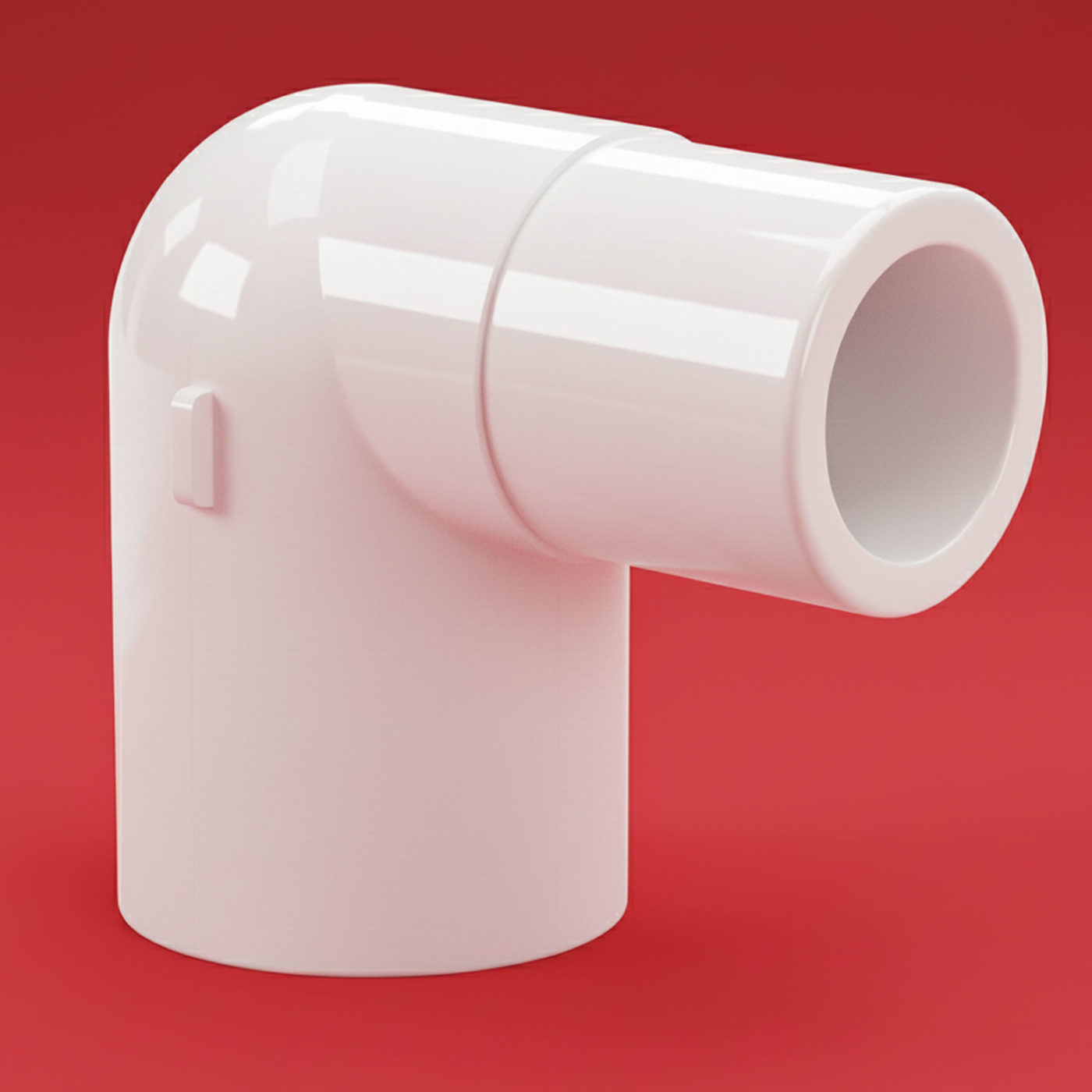
Street Elbow vs Regular Elbow
| Feature | Regular Elbow | Street Elbow |
|---|---|---|
| Connection Ends | Socket × Socket (both female) | Spigot × Socket (male × female) |
| Requires Coupling? | Yes, for connecting to another fitting | No — connects directly to another fitting |
| Space Efficiency | Larger overall assembly | More compact — ideal for tight spaces |
| Common Angles | 90° or 45° | 90° or 45° |
Because the street elbow has one spigot end, it can plug directly into another socket fitting, saving valuable space and reducing the number of joints. This makes it especially useful in confined areas like under sinks, behind walls, and inside mechanical enclosures.
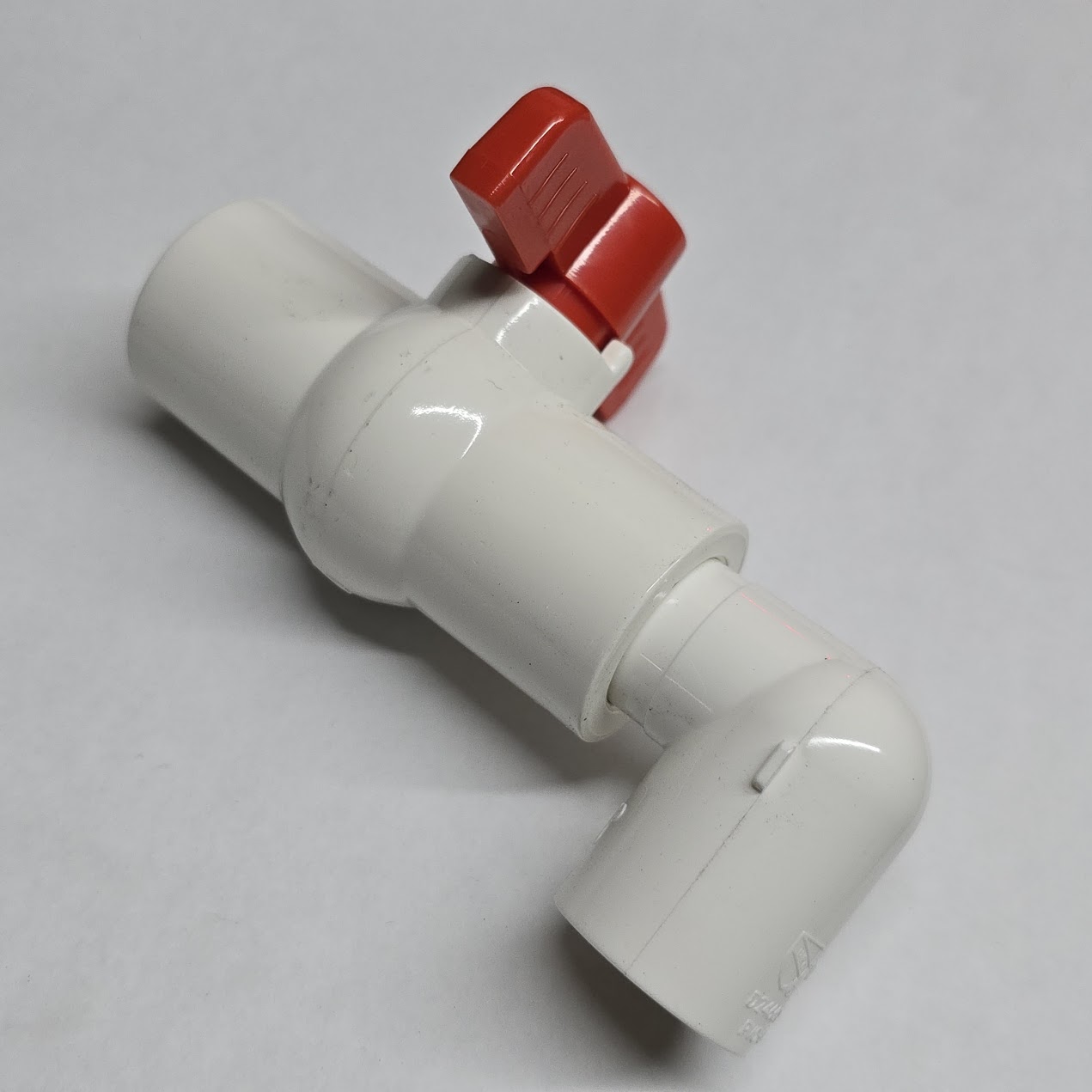
Common Applications for Street Elbows
Street elbows are widely used across multiple trades for tight or complex piping layouts. Below are some practical applications:
1. Plumbing Repairs and Retrofits
- Ideal for connecting pipes where space is limited.
- Simplifies repairs behind walls or beneath fixtures.
- Reduces the need for extra couplings and joints.
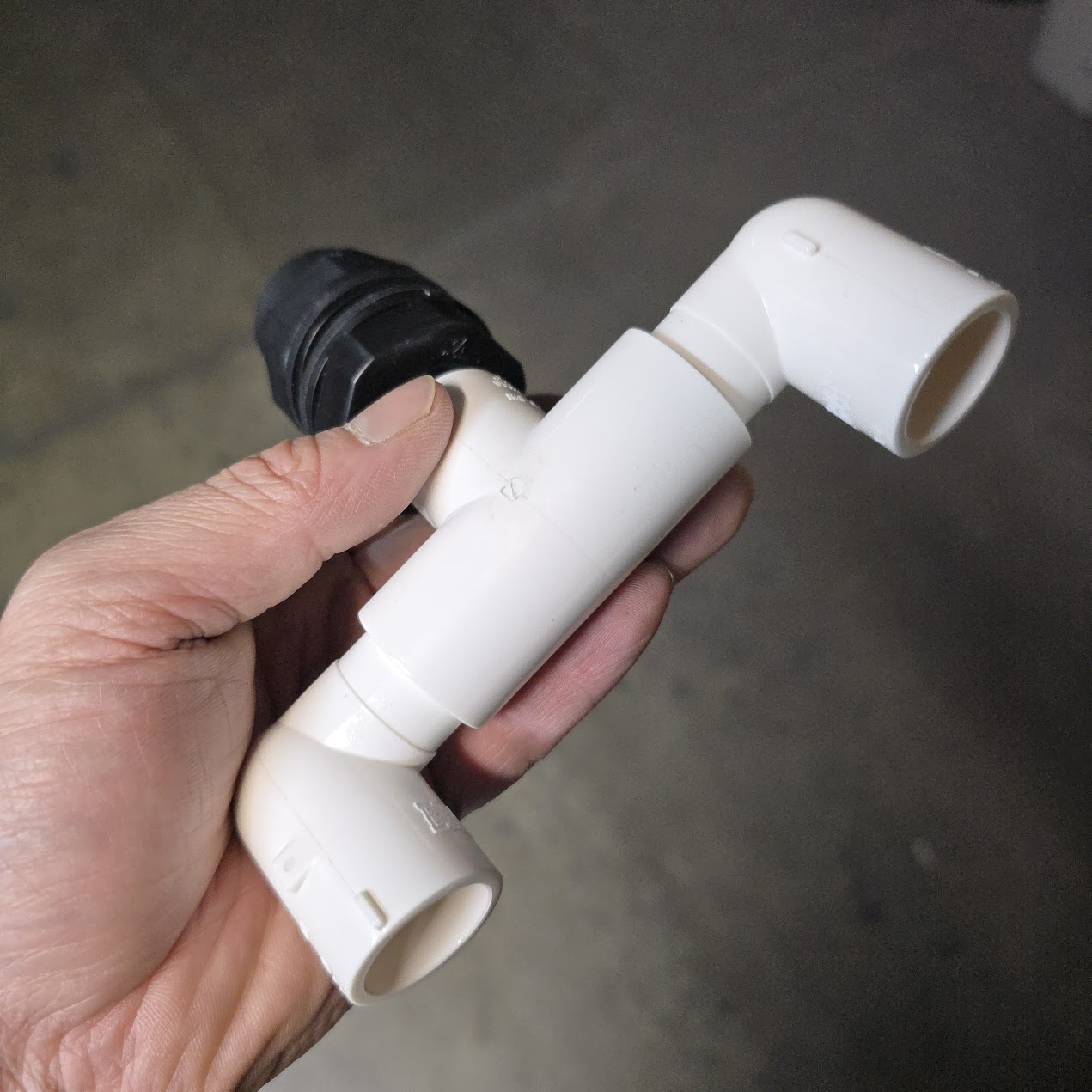
2. Irrigation and Landscaping
- Excellent for valve boxes and manifolds where fittings must fit closely together.
- Provides smooth directional changes in underground or surface irrigation systems.
- Simplifies routing around obstacles without increasing the footprint.
3. Hydroponic and Aquaponic Systems
- Perfect for compact systems where flow paths need to change direction quickly.
- Makes plumbing around pumps, filters, and tanks much easier.
4. HVAC Condensate and Drain Lines
- Used for tight-turn condensate drains in air handlers or rooftop units.
- Minimizes fitting count and allows for quick rerouting in small plenums.
5. Light Industrial and Lab Applications
- Suitable for small process systems, rinse stations, or water treatment setups.
- Allows precise layout adjustments in mechanical rooms and equipment skids.
6. DIY and Home Projects
- Useful for small water systems, garden projects, or temporary plumbing setups.
- Ideal for those who need compact, easy-to-assemble PVC connections.
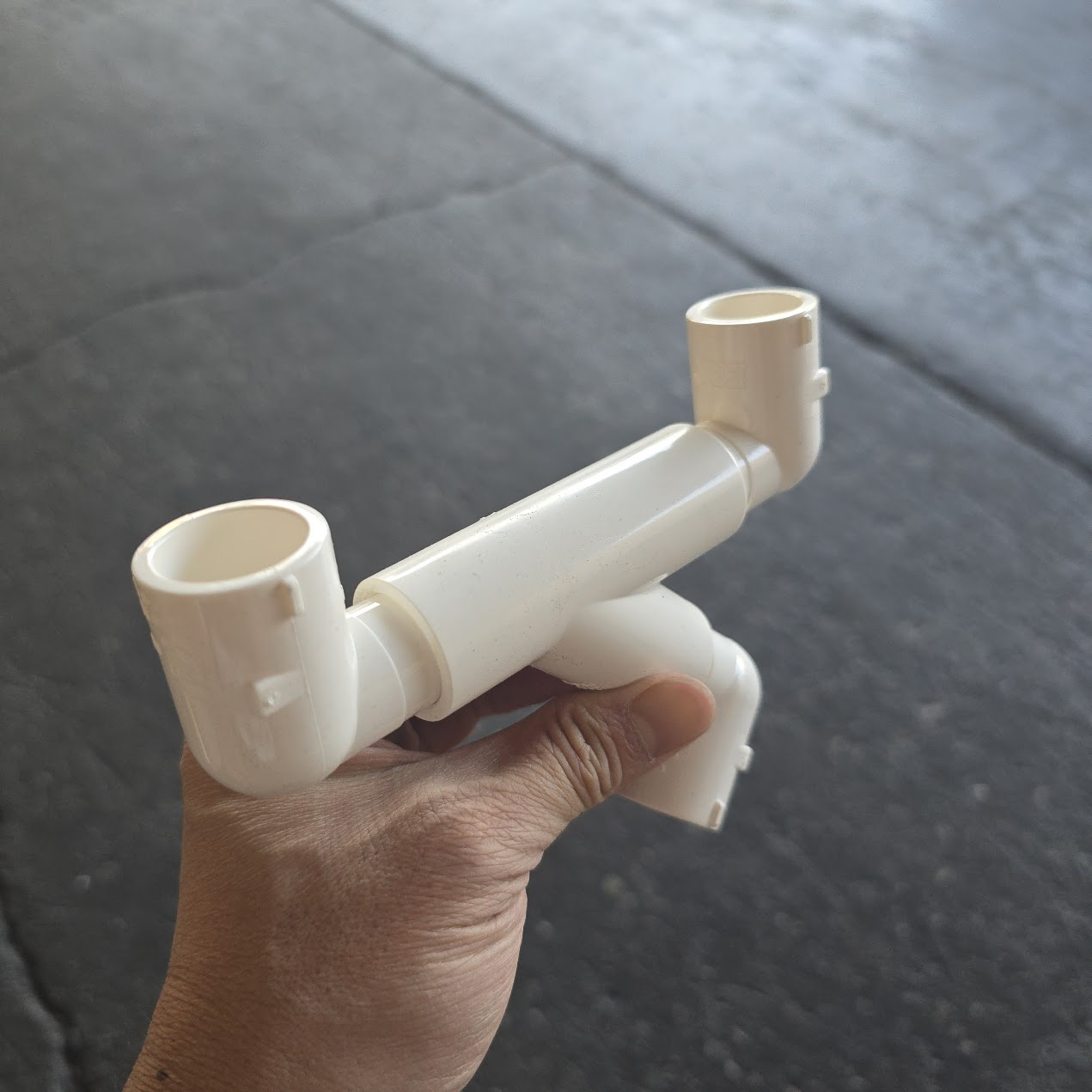
Why Choose 247Garden SCH-40 Street Elbows
247Garden’s Schedule 40 PVC 90-Degree Street Elbows are built to ASTM D2466 standards and are NSF certified for potable water applications. Designed for reliability and performance, these fittings are a proven choice for both residential and commercial systems.
Available Sizes: 1/2 inch to 2 inch
Connection Type: Slip × Spigot (90°)
Key Benefits
- Compact design reduces the number of fittings required.
- Made from high-strength PVC for long-term durability.
- Corrosion-resistant and non-reactive to most common chemicals.
- Smooth interior bore for improved flow efficiency.
- Easy to solvent-weld for a secure, leak-free joint.
When to Use SCH-40 vs SCH-80 Street Elbows
- Schedule 40 PVC Street Elbows: Best for standard pressure plumbing, irrigation, and HVAC drain systems.
- Schedule 80 PVC Street Elbows: Thicker walls for higher pressure and industrial applications where additional strength is required.
247Garden supplies both SCH-40 and SCH-80 fittings, giving professionals the flexibility to choose the right type for the job.
Other Recommended PVC Fittings from 247Garden
To complete your project efficiently, 247Garden offers a full range of Schedule 40 and Schedule 80 PVC fittings and valves.
Schedule 40 (ASTM D2466)
- PVC Couplings (Slip × Slip)
- PVC Tees (Slip × Slip × Slip)
- PVC Cross Fittings (4-Way)
- PVC Bushings and Reducers
- PVC Ball Valves and Check Valves (1/2"–2")
Schedule 80 (ASTM D2467)
- Heavy-Duty Elbows and Tees
- True-Union Ball Valves
- High-Pressure Check Valves
- Flanges and Union Fittings
Whether you are a plumber, contractor, HVAC technician, or irrigation professional, 247Garden offers consistent, durable fittings designed to meet job-site demands.
Final Thoughts
The street elbow may be small, but its value is undeniable. Its simple male-female configuration saves time, reduces material usage, and makes installation easier in tight or complex layouts.
For dependable performance and precision fit, choose 247Garden SCH-40 PVC Street Elbows, available from 1/2 inch up to 2 inches. Built to ASTM D2466 standards and NSF certified, these fittings deliver reliability across plumbing, irrigation, and HVAC applications.
[related_products is_auto_added="1"]When you’re installing plumbing, irrigation, or HVAC piping, space and efficiency are everything. One of the simplest yet most valuable fittings you can have in your toolbox is the street elbow. Whether you’re a contractor, plumber, irrigation specialist, or HVAC technician, understanding what a street elbow is — and when to use it — can […]
When selecting a PVC shut-off valve, one small detail can make a big difference in long-term performance — whether the internal ball is chromed or non-chromed. While both versions perform the same basic task — controlling liquid flow — their construction and finish affect sealing ability, smoothness of operation, and resistance to wear or chemicals.
To help you choose the right type for your system, let’s explore how these two designs differ, and why the 247Garden Two-Piece Schedule 40 PVC Chromed Ball Shut-Off Valve (ASTM D2466) is a strong, reliable choice for everyday use.
Understanding How a Ball Shut-Off Valve Works
A ball shut-off valve controls flow by rotating a hollow, spherical ball inside the valve body. When the hole in the ball aligns with the pipe, fluid passes through. When the ball is turned 90 degrees, the passage closes, stopping flow completely.
Because the ball surface moves against a sealing seat, its finish and material directly affect how tightly the valve seals and how easily it operates.
Chromed Ball: Smooth, Durable, and Precise
A chromed ball is made from PVC or ABS and plated with a thin layer of chrome. This creates a smooth, mirror-like surface that greatly improves sealing and operating performance.
Advantages of a Chromed Ball:
- Smooth Operation: The polished surface reduces friction, allowing easier on/off control.
- Tighter Seal: The precision finish creates better contact with the valve seat, reducing the risk of small leaks.
- Enhanced Durability: Chrome plating adds wear resistance for systems that are opened and closed frequently.
- High-Pressure Performance: Ideal for water and general-purpose applications where reliability matters.
Limitations:
Chrome coatings can lose their protective qualities if scratched or exposed to harsh acids or caustic chemicals. For aggressive fluids, a solid PVC ball may be more suitable.
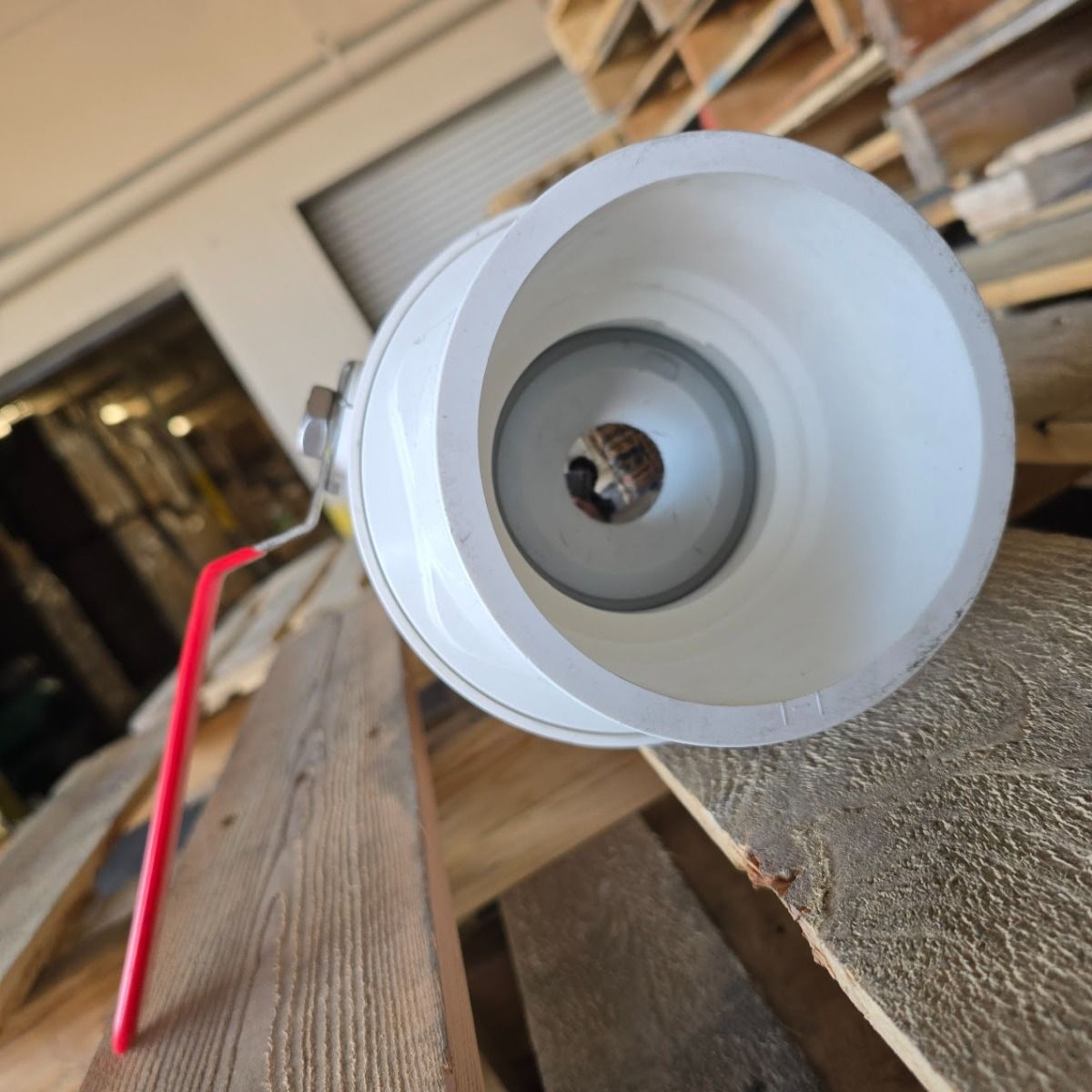
Non-Chromed Ball: Lightweight and Chemically Resistant
A non-chromed ball is made entirely from solid PVC or CPVC material. While it lacks the ultra-smooth finish of chrome plating, it excels in environments where chemical resistance is the top priority.
Advantages of a Non-Chromed Ball:
- Excellent Chemical Resistance: Fully compatible with corrosive or chemically reactive fluids.
- Low Opening Pressure: Lighter weight means the valve opens easily in low-pressure or gravity-fed systems.
- No Coating to Chip or Flake: Ideal for systems where long-term chemical stability is essential.
Limitations:
Because the surface is not plated, the ball can experience slightly higher friction and may wear faster in high-pressure or high-cycle use.
Key Comparison
| Feature | Chromed Ball | Non-Chromed Ball |
|---|---|---|
| Surface Finish | Polished, chrome-plated | Matte or slightly textured PVC |
| Chemical Resistance | Moderate (limited by plating) | Excellent |
| Wear Resistance | Very high | Moderate |
| Ease of Operation | Smooth and precise | Slightly higher friction |
| Ideal Pressure Range | Medium to high | Low to medium |
| Best Use | Water, irrigation, plumbing | Chemical dosing, low-pressure flow control |
Recommended Product: 247Garden Two-Piece Schedule 40 PVC Chromed Ball Shut-Off Valve with Stainless Steel Handle (ASTM D2466)
For strong, dependable manual flow control, the 247Garden Two-Piece Schedule 40 PVC Chromed Ball Shut-Off Valve offers professional-grade performance with a durable, user-friendly design.
Engineered to meet ASTM D2466 standards, this valve ensures precise fitment and consistent quality across a wide range of plumbing and irrigation systems. Its chromed ball interior provides smooth rotation and a tight seal, while the stainless steel handle gives you firm, corrosion-resistant control.
Product Features:
- Two-Piece Body Design: Easy to install, service, and replace without removing the entire line.
- Schedule 40 PVC Construction: Strong yet lightweight, resistant to rust and corrosion.
- Chromed Ball Core: Provides smooth actuation and long-lasting sealing performance.
- Stainless Steel Lever Handle: Durable, rust-resistant, and comfortable for frequent operation.
- Slip/Socket Ends: Compatible with standard Schedule 40 PVC pipes for solvent-weld assembly.
- ASTM D2466 Compliant: Manufactured to precise PVC fitting standards for reliability and dimensional accuracy.
Typical Applications:
- Hydroponic and irrigation systems
- Pool and spa water control
- Greenhouse and aquaculture installations
- Water distribution and filtration setups
- General plumbing and shut-off systems
With its chromed interior ball and stainless steel handle, this valve is designed for long-term performance in environments that require dependable manual shut-off and smooth flow control.
Available Sizes: 1/2 inch to 4 inch
Manufacturer: 247Garden
Conclusion
Choosing between a chromed ball and a non-chromed ball PVC valve depends on your system’s needs.
If you require smooth operation, tight sealing, and high durability, a chromed ball shut-off valve like the 247Garden Two-Piece Schedule 40 PVC Chromed Ball Valve (ASTM D2466) is the right solution.
If your application involves chemicals or highly corrosive fluids, a non-chromed PVC valve may be the safer and more economical option.
Either way, 247Garden offers a complete line of Schedule 40 and Schedule 80 PVC valves and fittings, providing reliable control and long service life for irrigation, hydroponic, and industrial systems.
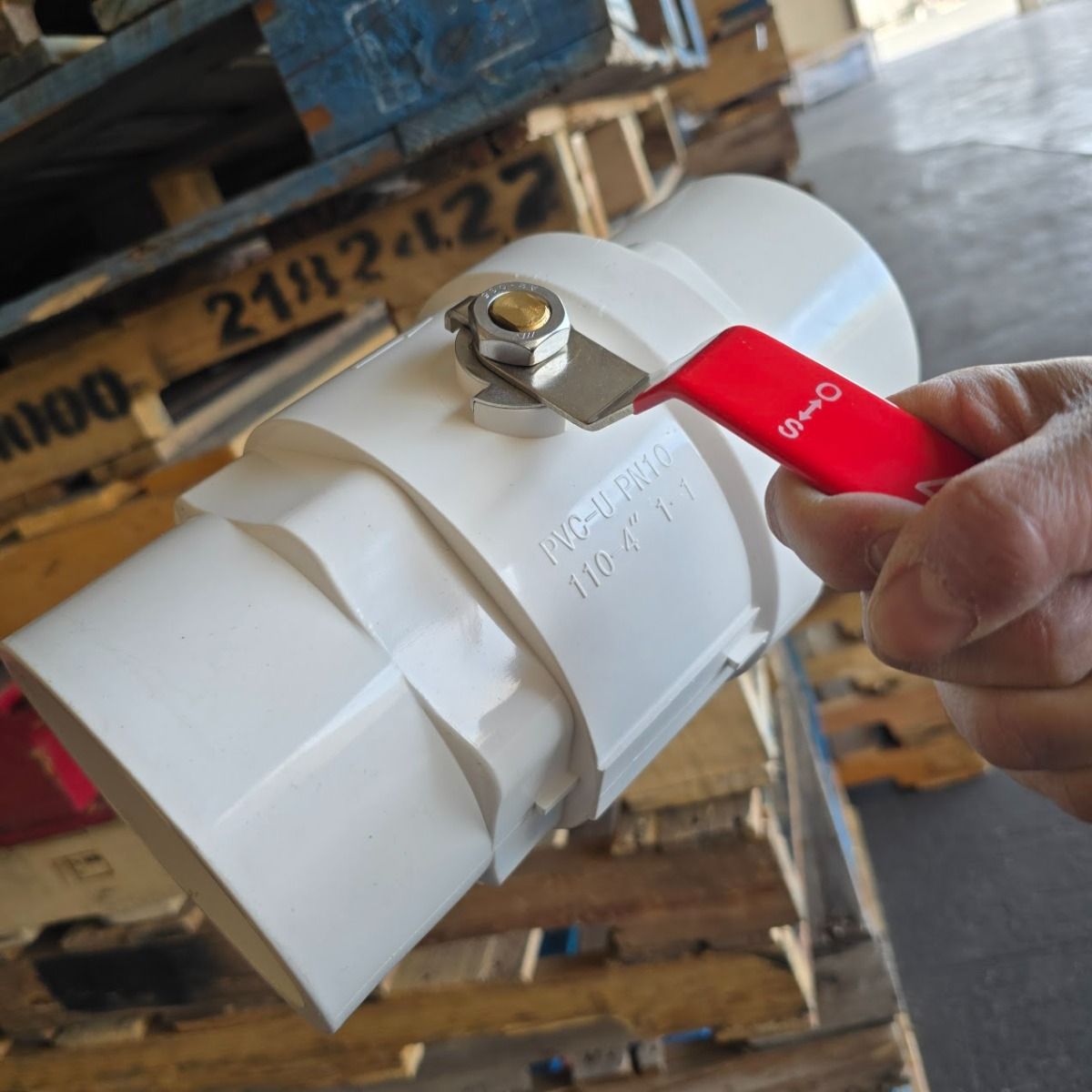
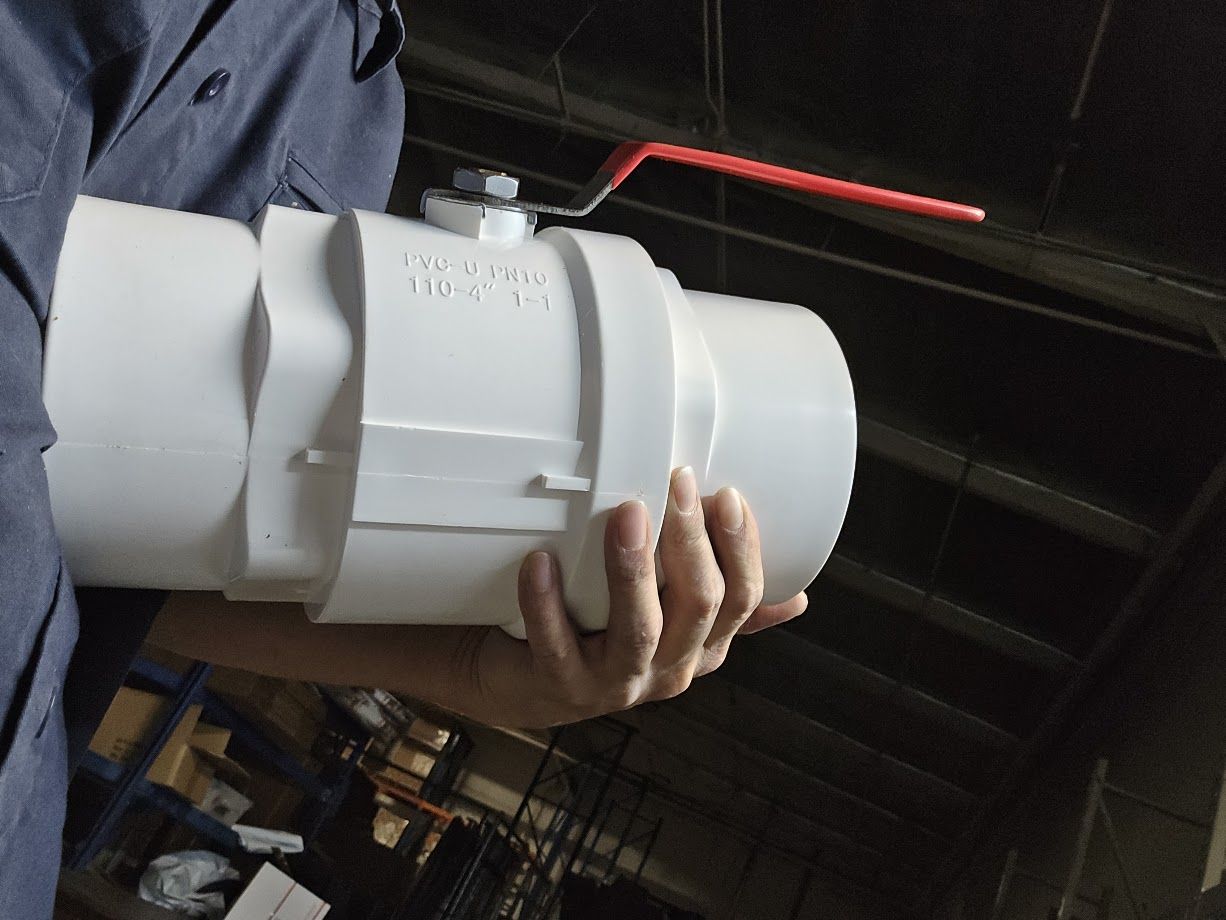
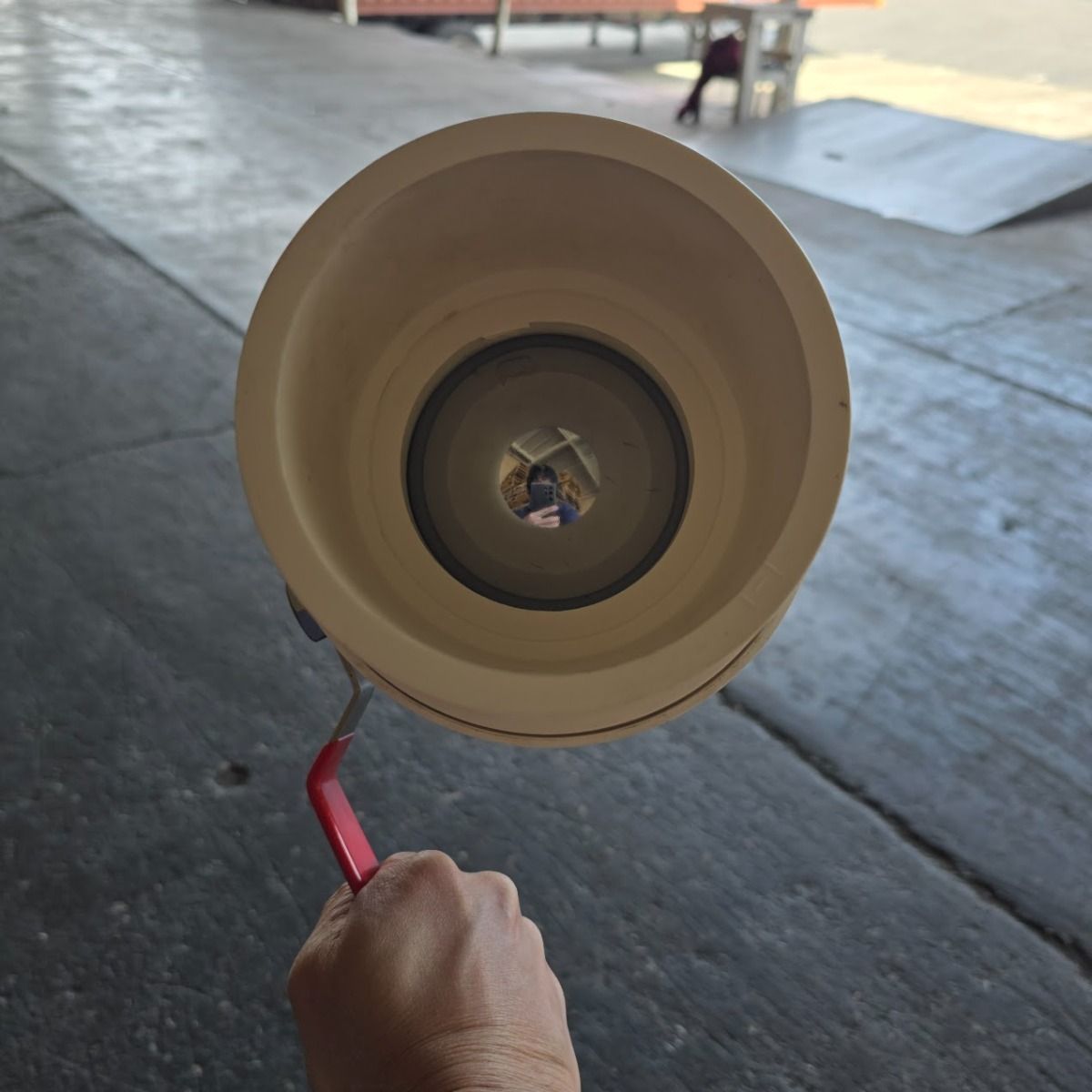
When selecting a PVC shut-off valve, one small detail can make a big difference in long-term performance — whether the internal ball is chromed or non-chromed. While both versions perform the same basic task — controlling liquid flow — their construction and finish affect sealing ability, smoothness of operation, and resistance to wear or chemicals. […]
Sure! Here’s a big list of 100 practical, creative, and industrial things you can do with a Schedule 40 PVC Cross (4-way fitting) — spanning plumbing, irrigation, hydroponics, DIY, furniture, and fun projects.
Plumbing, Irrigation & Water Systems
- Split water flow into four directions
- Connect four drainage lines
- Build a central junction in a drip irrigation system
- Connect garden hose extensions
- Create a multi-zone sprinkler hub
- Distribute flow in hydroponic nutrient systems
- Balance pressure between multiple irrigation lines
- Build a greywater distribution system
- Connect aquarium water return lines
- Make a central manifold for a pond filter system
- Create a rain collection diverter
- Connect roof downspout diverters
- Split water flow in aquaponics setups
- Build a DIY sump return manifold
- Make a water testing manifold for experiments
- Connect pool plumbing return lines
- Build a fish hatchery water distribution point
- Route pipes underground in four directions
- Create a low-pressure misting system
- Combine air and water lines for aeration systems
Hydroponics & Gardening
- Build hydroponic grow frame supports
- Create nutrient solution manifolds
- Make a drip feed cross-distributor
- Build plant trellis corners
- Create grow light support frames
- Assemble a hydroponic NFT system framework
- Build a vertical garden stand
- Construct tomato cages with PVC crosses
- Make modular planter box frames
- Create irrigation supports for raised garden beds
- Connect misting nozzles in an aeroponic system
- Build a compact hydroponic manifold hub
- Create a greenhouse support structure
- Build a seedling table with irrigation ports
- Make a rainwater redistribution system for planters
DIY Furniture & Storage
- Build a PVC shelving system
- Create a modular shoe rack
- Make a PVC workbench frame
- Assemble a garden hose reel frame
- Build a portable clothes drying rack
- Make a photography light stand
- Build a 3D cube display rack
- Create garage storage frames
- Construct a PVC laundry basket stand
- Make a kids’ toy organizer
- Build a small table or work surface frame
- Create a computer monitor riser
- Assemble a book or record display stand
- Make a small kitchen storage frame
- Create a towel rack for poolside use
Outdoor & Recreational Projects
- Build a camping chair frame
- Create a backyard canopy structure
- Assemble a tent frame or awning
- Build a portable shade canopy
- Make a soccer goal frame
- Construct a volleyball or badminton net stand
- Build a portable outdoor shower stand
- Create a hammock stand base
- Build a garden umbrella base
- Make a portable boat shade canopy
Pet & Animal Projects
- Build a small animal playpen frame
- Make a chicken feeder support
- Build a parrot play gym
- Create a rabbit hutch support frame
- Assemble a dog agility obstacle
- Make a birdbath water manifold
- Construct a reptile misting system hub
- Build a fish tank plumbing manifold
- Create a pet drying rack frame
- Make a hydroponic-style aquarium water return
Workshop, Hobby, & Utility Uses
- Build a PVC tool rack
- Create a paint-drying stand
- Assemble a camera tripod base
- Build a model display or diorama support
- Create an electronics testing frame
- Make a custom work light support
- Build a drone repair stand
- Construct a model rocket launch pad
- Create a 3D printer filament rack
- Make a shop vacuum hose splitter
Garage, Vehicle, & Marine Uses
- Build a car wash foam gun manifold
- Create a hose drying rack
- Make a kayak rack
- Build a fishing rod holder
- Construct a trailer light wiring support
- Create a marine bilge water splitter
- Build an RV fresh water distribution manifold
- Make a portable gas line test frame (for air pressure tests)
- Assemble a small engine cleaning manifold
- Build a bike repair or wash stand
Kids & Educational Projects
- Build a kids’ play cube
- Create a marble run frame
- Build a PVC water play table
- Make a science fair plumbing demo
- Create a DIY sprinkler toy
- Build a bubble machine frame
- Make a PVC mini carwash for toy cars
- Construct a STEM project water network
- Build a small robot chassis or structure
- Make a four-way airflow demonstration for classroom experiments
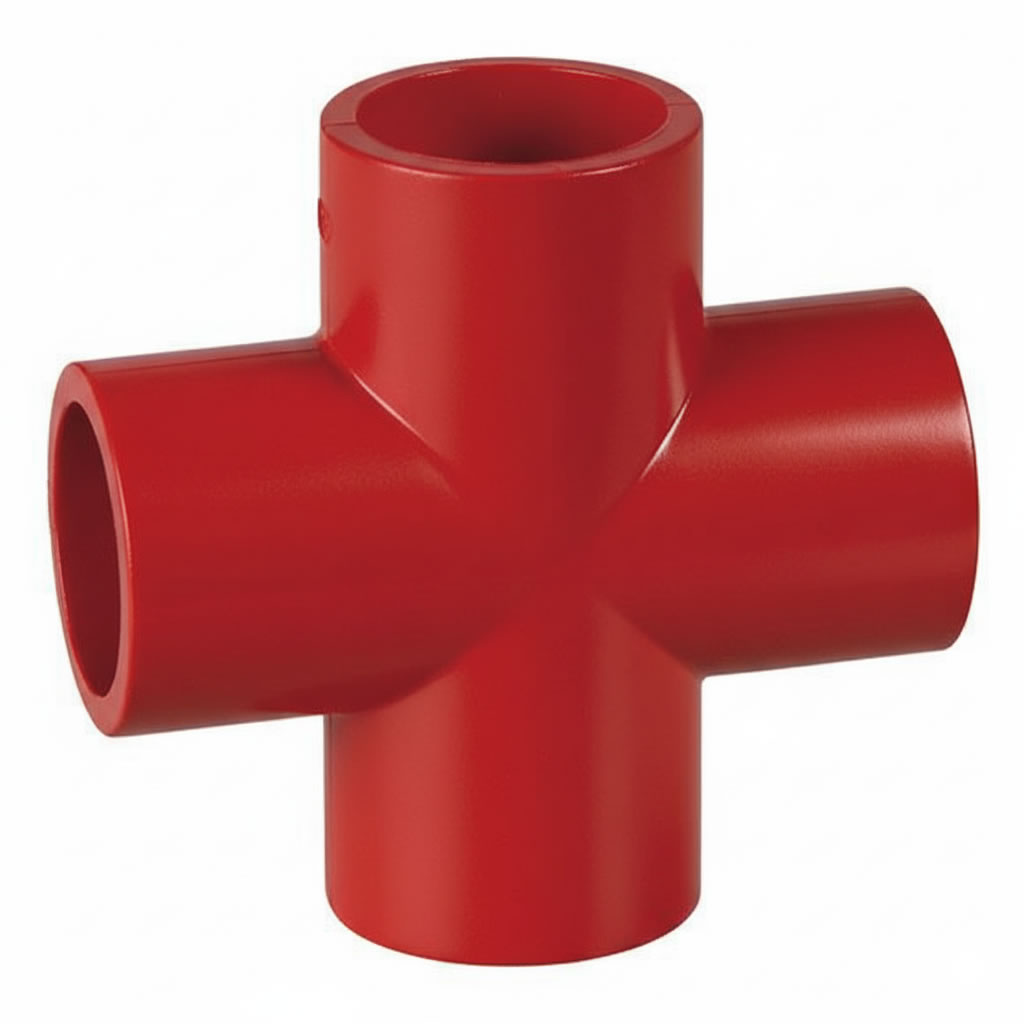
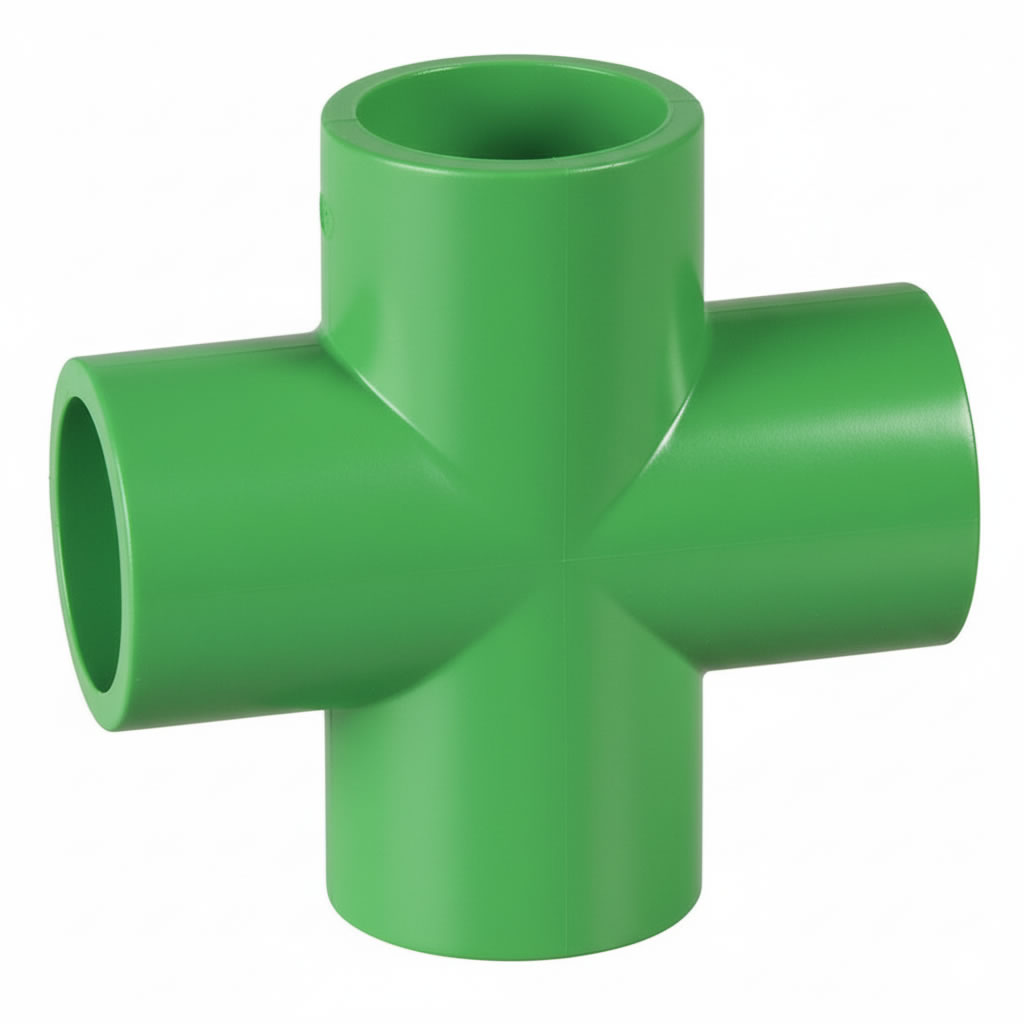
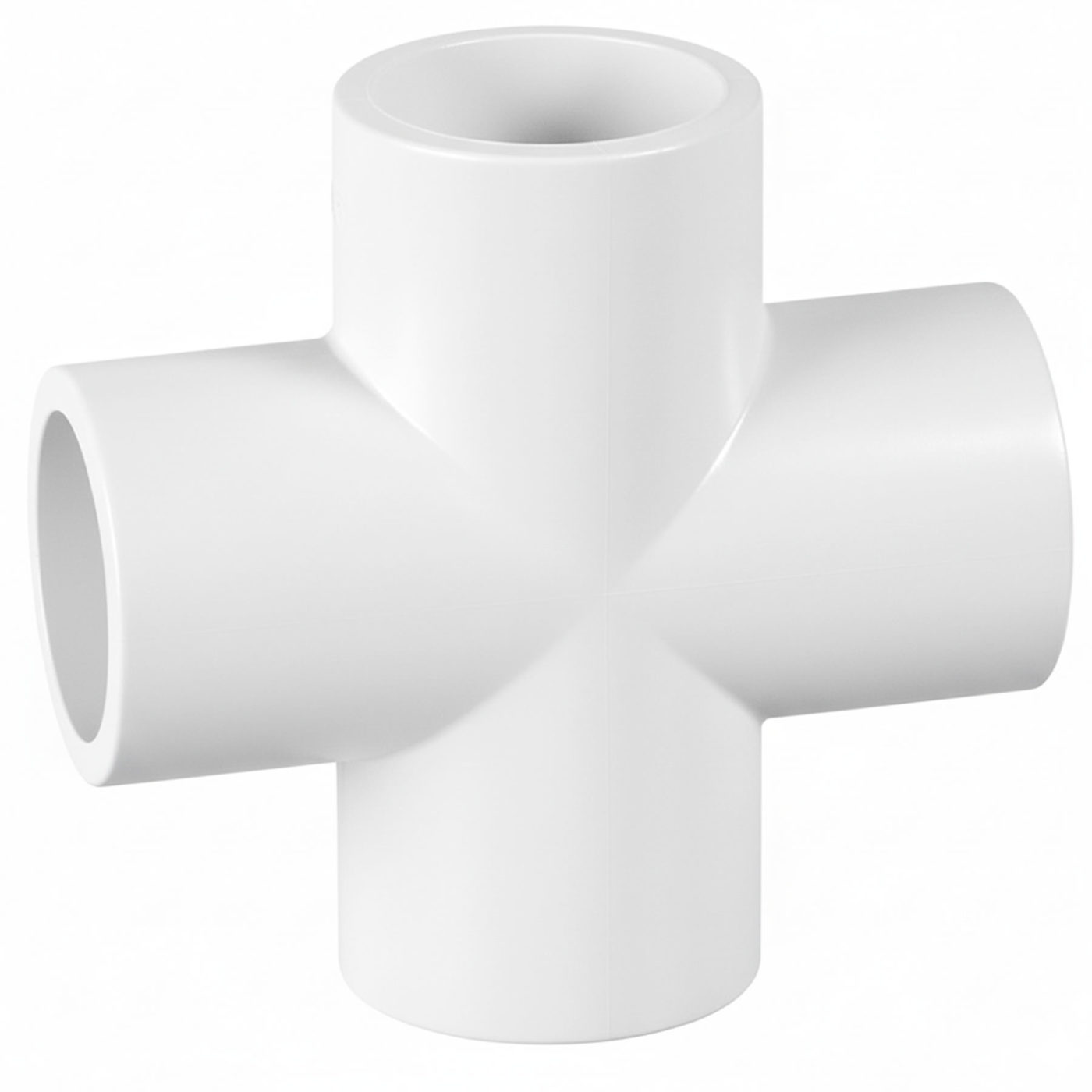
Sure! Here’s a big list of 100 practical, creative, and industrial things you can do with a Schedule 40 PVC Cross (4-way fitting) — spanning plumbing, irrigation, hydroponics, DIY, furniture, and fun projects. Plumbing, Irrigation & Water Systems Hydroponics & Gardening DIY Furniture & Storage Outdoor & Recreational Projects Pet & Animal Projects Workshop, Hobby, […]
A True-Union Ball Check Valve is a non-return valve designed to allow fluid to flow in one direction only while automatically preventing backflow. It operates using a free-floating ball that seals against a seat when flow reverses.
It’s called a “true-union” valve because both ends of the body have union fittings, allowing the valve body to be removed for cleaning or maintenance without cutting or re-gluing any pipe.
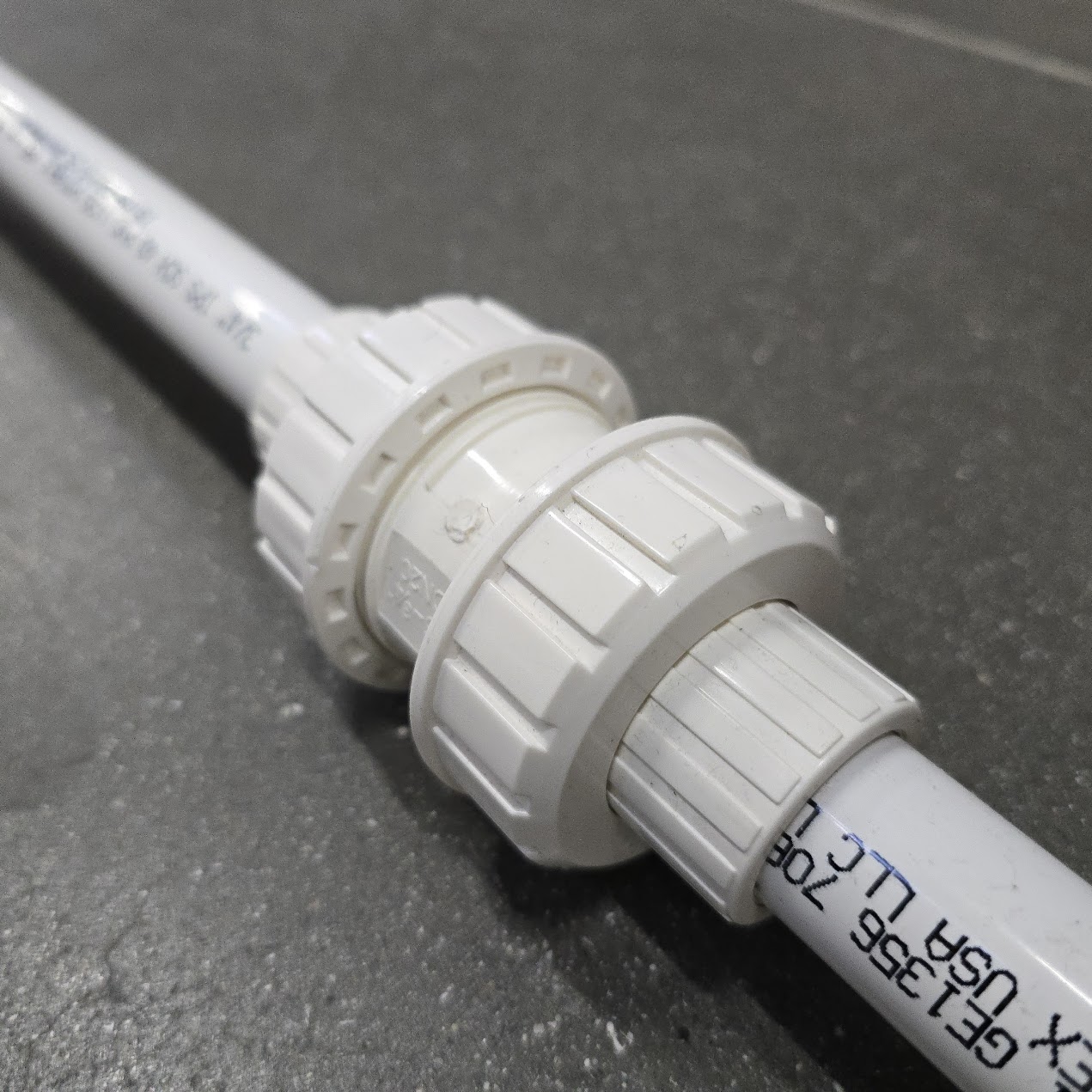
How It Works — Step by Step
1. Forward Flow (Normal Operation)
When fluid enters from the inlet side, the pressure pushes the ball away from the seat, creating an open passage.
The ball moves slightly upward or downstream, depending on the valve’s orientation, allowing the liquid to pass freely through the valve with minimal resistance.
At this point, the valve is open, and flow continues normally.
2. Reverse Flow (Backflow Prevention)
When flow stops or attempts to reverse direction, pressure from the opposite side or gravity causes the ball to move back onto the seat.
The ball seals tightly against the valve seat, blocking fluid from returning through the line.
This automatic action prevents siphoning, contamination, or pressure loss in upstream equipment such as pumps or tanks.
At this point, the valve is closed, preventing backflow.
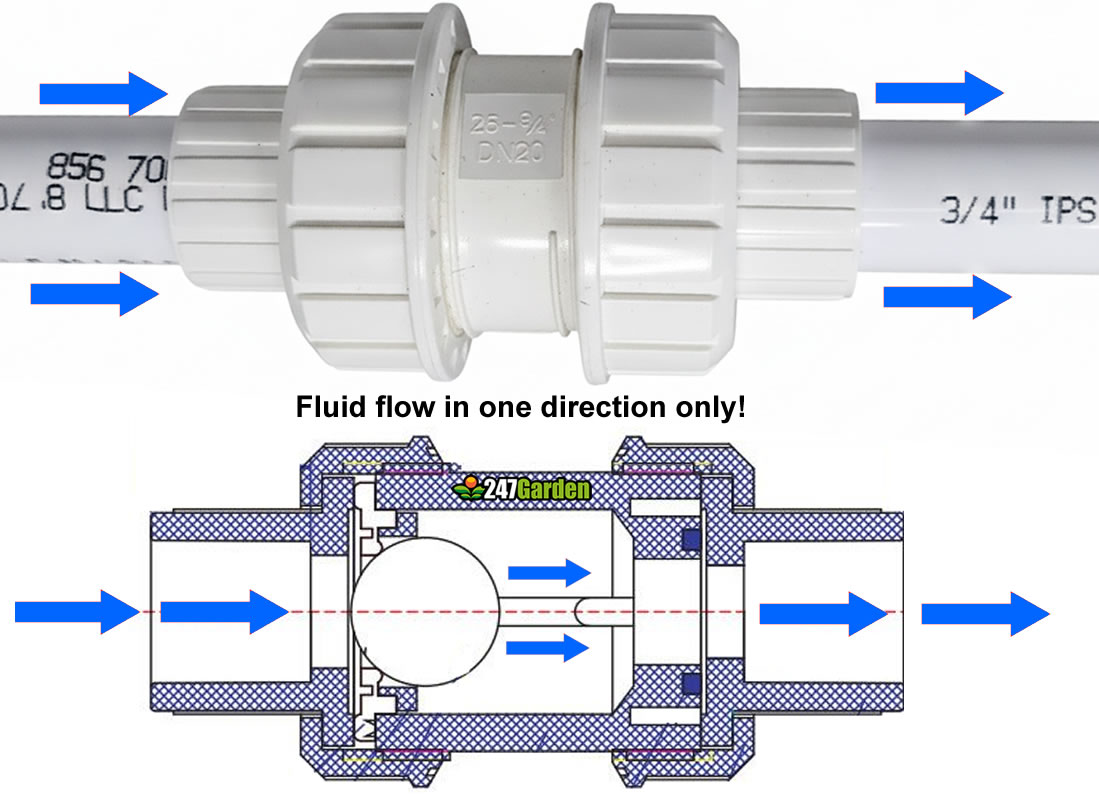
3. Automatic Reset
As soon as forward pressure resumes, the ball lifts again, reopening the passage for normal flow.
This cycle repeats automatically and requires no manual operation or external control.
Internal Components and Functions
| Component | Description |
|---|---|
| Valve Body | The main housing, typically made of PVC, CPVC, or PVDF for corrosion and chemical resistance. |
| Union Ends x 2 | Allow quick removal of the valve body for cleaning or replacement without disturbing the rest of the pipeline. |
| Ball | The moving element that seals or unseals the flow path. It is usually made from PVC or a weighted material. |
| Seat | The sealing surface against which the ball rests to block reverse flow, typically made from EPDM or Viton. |
| O-Rings | Provide leak-free seals between the union ends and valve body. |
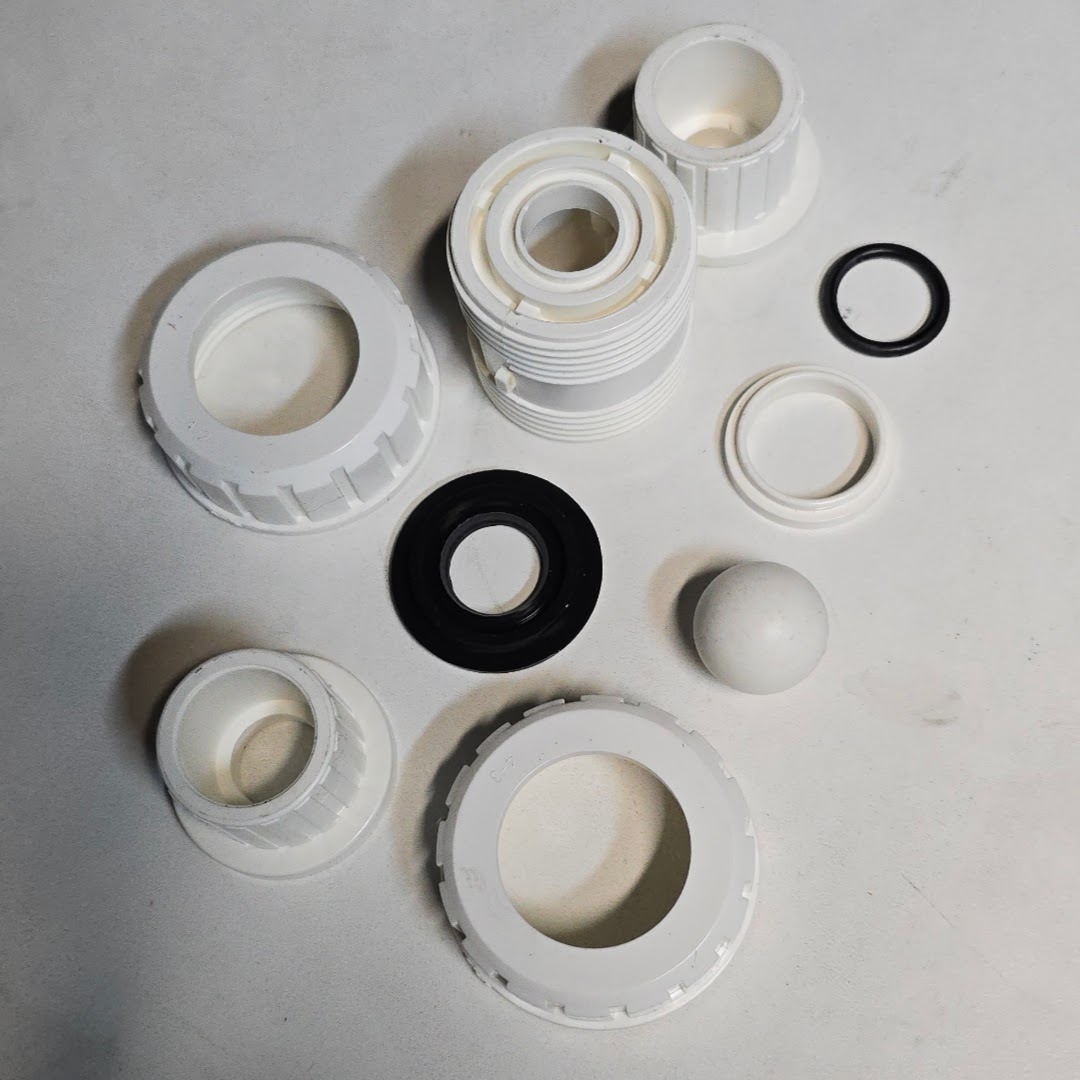
Practical Example — Irrigation or Hydroponics
Consider a hydroponic system with a pump circulating nutrient solution to multiple grow lines:
- When the pump is running, pressure lifts the ball, allowing fluid to flow freely through the valve.
- When the pump stops, gravity and reverse pressure push the ball back against the seat, preventing the nutrient solution from draining backward into the reservoir.
This prevents siphoning, air introduction, and cross-contamination between different parts of the system.
The same principle applies to irrigation lines, chemical dosing systems, aquarium returns, and industrial water loops.
Why the “True-Union” Design Matters
Many check valves are glued or threaded permanently into a pipeline. When they fail or clog, the only way to service them is to cut out the valve and replace it.
With a true-union design, you can:
- Unscrew both union nuts,
- Remove the valve body,
- Clean or replace the internal parts,
- Reinstall it easily.
This design saves time, reduces downtime, and extends the system’s service life.
Key Advantages
- Reliable automatic backflow prevention
- Simple design with minimal moving parts
- Easy maintenance and cleaning
- Resistant to corrosion and chemicals
- Works in both horizontal and vertical installations (vertical flow-up is preferred)
- Compatible with Schedule 40 or Schedule 80 piping
Example: 247Garden True-Union Ball Check Valves
For dependable performance in industrial, agricultural, and water treatment systems:
- 1/2" to 2" sizes – Ideal for Schedule 40 PVC piping in hydroponics, irrigation, or aquarium systems.
- Up to 4" sizes – Suitable for Schedule 80 piping in higher-pressure industrial or municipal systems.
Each 247Garden True-Union Ball Check Valve features:
- Durable PVC body and union ends,
- Precision-molded sealing ball and seat,
- EPDM or Viton seals for broad chemical compatibility,
- Easy serviceability and long-term reliability.
A True-Union Ball Check Valve is a non-return valve designed to allow fluid to flow in one direction only while automatically preventing backflow. It operates using a free-floating ball that seals against a seat when flow reverses. It’s called a “true-union” valve because both ends of the body have union fittings, allowing the valve body […]
Composting is one of the best ways to recycle organic waste and create nutrient-rich soil for your garden. While many people use plastic bins or wooden enclosures, 247Garden Grow Bags offer a simple, effective, and eco-friendly alternative. The breathable fabric design makes them perfect for composting, allowing air and moisture to circulate while holding large amounts of organic material.
Why Choose Grow Bags for Composting
Unlike solid bins that trap moisture and restrict airflow, 247Garden Grow Bags naturally provide aeration. This airflow helps beneficial microbes break down kitchen scraps, yard waste, and leaves more efficiently. The fabric also drains excess water, preventing soggy compost and reducing odors. When it’s time to collect finished compost, you can easily tip the bag over or scoop it directly from the top.
Using a Cover for Better Results
Adding a cover to your compost grow bag can improve the process and protect your pile. A simple tarp or fitted lid works well. Here’s why covering helps:
- Moisture Control: Prevents the pile from getting waterlogged during heavy rain and helps retain moisture in hot weather.
- Heat Retention: Traps warmth inside the pile, speeding up decomposition and helping maintain consistent composting temperatures.
- Pest Prevention: Keeps animals, insects, and rodents from disturbing the compost.
- Odor Reduction: Helps contain any smells that may develop during breakdown.
Best Grow Bag Sizes for Composting
The ideal composting sizes range from 40 to 100 gallons, depending on your needs:
- 40-Gallon: Compact and beginner-friendly, great for small gardens or limited spaces.
- 50-Gallon: Balanced size, heats up quickly and produces steady compost.
- 65-Gallon: Medium-large option, perfect for families generating regular organic waste.
- 80-Gallon: Large capacity, ideal for serious gardeners needing more compost supply.
- 100-Gallon: Maximum size, excellent for farms or anyone handling large amounts of organic material.
Tips for Success
- Place the grow bag directly on soil so worms and beneficial microbes can join the process.
- Balance green waste (food scraps, grass) with brown waste (dry leaves, cardboard).
- Keep compost damp but not soaked, similar to a wrung-out sponge.
- Mix or turn the compost every few weeks to keep decomposition active.
- Use a cover to protect your pile and keep conditions stable.
Final Thoughts
Using 247Garden Grow Bags as compost bags is a smart, space-saving solution for turning everyday waste into valuable compost. With sizes ranging from 40 to 100 gallons, there’s a perfect option for every gardener, from small backyards to large farms. Strong, breathable, and reusable, these grow bags—especially when paired with a cover—make composting easy and efficient.
Composting is one of the best ways to recycle organic waste and create nutrient-rich soil for your garden. While many people use plastic bins or wooden enclosures, 247Garden Grow Bags offer a simple, effective, and eco-friendly alternative. The breathable fabric design makes them perfect for composting, allowing air and moisture to circulate while holding large […]